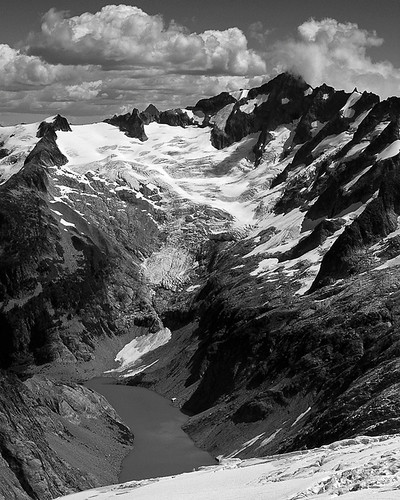
I love the smell of old books. And the feel of them, wrinkled and torn and soft around the edges. I can't remember now how I came across this book – The Wild Cascades Forgotten Parkland – but did somehow so in an instant ordered it from a bookseller in town and just found it stuffed in my mailbox today. It was published by the Sierra Club back in 1965, written by an eccentric character named Harvey Manning (who wrote countless guidebooks for the Cascades) who is a Cascades explorer, writer and editor and has – as the Sierra Club's David Brower writes in the acknowledgments – "the Cascade River flowing through the arteries on his right side and the Stehekin on his left." The purpose was to convince a public that the North Cascades needed saving. Saving from the bulldozers and the logging trucks. As justice William O. Douglas writes from Goose Prairie, Washington in the Foreword ~

If we do not preserve the remaining samples of primitive America, we will sacrifice traditional American values, the values of frontier America. Not every citizen goes to the wilderness – and they did not even 300 years ago. But so long as there is the presence of wilderness and the option of going to see it, a certain number of citizens do go there and bring back a message for their fellows. As long as that continues we will retain a historic connection with the past of our nation – and our race.
Upon first inspection, it is a beautiful book. I've now been introduced to the simple photography of the late Philip Hyde, who apparently studied alongside Ansel Adams. His black and white photographs from the Cascade Pass region (coincidentally, where I'm headed back again on Saturday) are simply spectacular, and in an instant convinced me to lug a Hasselblad and a couple of lenses up to the pass because that area is as rugged and as beautiful as one can hardly imagine.
I have, upon first setting foot on rock and ice here, felt a certain connection with the North Cascades. They are like no other mountain range on earth, and certainly unlike any range I have visited. They have been called a masterpiece. They have a quality – a ruggedness, pristineness, softness and stillness – about them that I just cannot do justice. Photographs cannot do justice. But a walk through the damp cedar and fir forests clinging to the western slopes, a climb high above the valleys and the clouds crampons crunching on solid glacial ice, a moment standing still in the crisp air of views unimaginable – those can. It is a new adventure – a new experience – every time I find myself there. They are a home to me, a place I can go to find an almost unbearable amount of reflection.
I've hiked through the ranges of the Sierras and the Rockies and the Winds, but none of them call me back the same way as these jagged, impressive peaks with their inspiring glaciers and massive struts of elevation from valley floors lined with fir and fog. Each time I return, I'm only more inspired to go back.
Throughout the book, the poetry of Theodore Roethke weaves in and out of the the pages of Manning's eloquent prose. Interspersed and molding with the spectacular photography of Philip Hyde (as mentioned), David Simons, Bob and Ira Spring, Ansel Adams and others. The images of the Chilliwack Range; of Glacier and Dome and Forbidden Peaks; of the South Cascade Glacier; of Image Lake, floating ice in Doubtful Lake, a lake in the White Chuck Basin; of Bridge Creek and the head of Flat Creek – all of these stir memories of my own images, my own travels up the spines of mountain ridges, glaciers clinging far below. Of finding my way through fogs and whiteouts and blizzards and raging storms. Of standing on summits surrounded by seas of peaks.
Under a photograph by Bob and Ira Spring of Forbidden Peak at sunset (a view I've soaked up on my climbs up Eldorado Peak, looking across the Inspiration Glacier to the north face and the Forbidden Glacier that tumbles in a beautiful mess to the deep turquoise waters of Moraine Lake far, far below) Roethke writes without assumption most fittingly (and most excerpts are labeled as just that – untitled extractions of a larger work) ~
And I acknowledge my foolishness with God,My desire for the peaks, the black ravines, the rolling mistsChanging with every twist of wind,The unsinging fields where no lungs breathe,Where light is stone.
Clearly, the book's efforts paid off and the North Cascades National Park (created by Congress in 1968, three years after publication) was established and protects these wild lands and incredible wilderness for me and all others beckoned and inspired to explore. I'm grateful for the foresight of those that put this together, this incredible collection of poetry, prose and photography – all of a place that is and will always be to me home.


1 comment:
I've had this post on an open tab in my browser for a week plus trying to find a moment to finish reading it and comment.
1) I'll say it again. I wish you'd make photos you post in your blog public, I love the one in this post 1292.jpg, the granite fins and ice.
2) Beautiful words, well written and sums up what I have loved that I have found about living in Washington, the Cascades are our hidden secret the world knows nothing about.
Cheers
mbg
Post a Comment